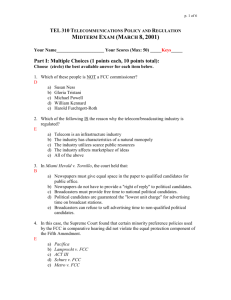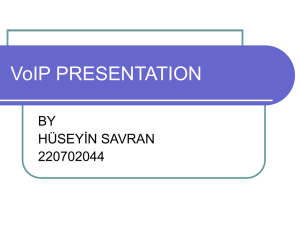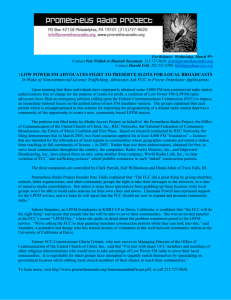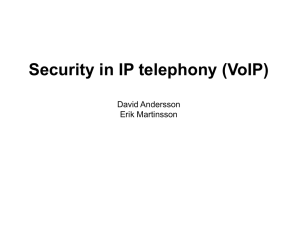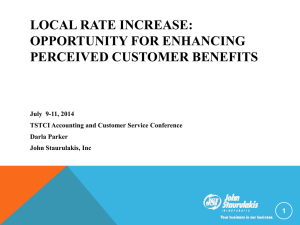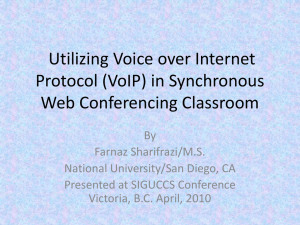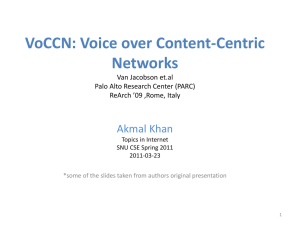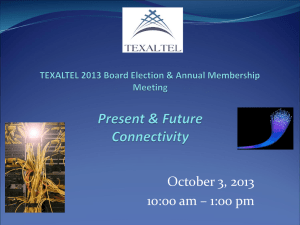FCC Regulation of Non-Interconnected VoIP Services and the “Cloud”
advertisement
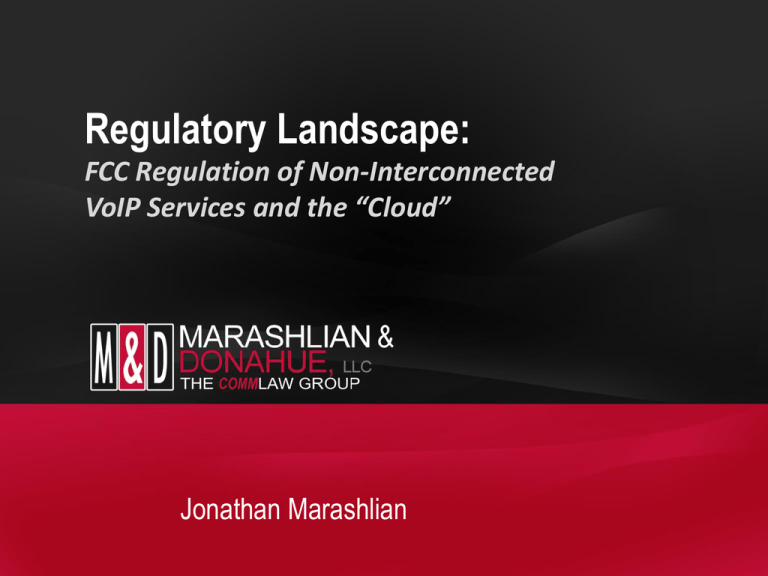
Regulatory Landscape: FCC Regulation of Non-Interconnected VoIP Services and the “Cloud” Jonathan Marashlian Introduction • Welcome to the uncertain regulatory universe of the “Cloud” – Cloud-based communications use the Internet as a means of transmission and rely on software applications for the intelligence • Why do telecommunications regulations matter? Is “Video” even regulated? – Everything is converging over IP – With convergence comes bundling and bundling regulated with unregulated no longer preserves the bundle as unregulated • Success leads to substitution of traditional services and diminution of support revenue, ultimately leading to expansion of regulations and taxes Brief History • The Future of VoIP: Regulatory Storm Clouds on the Horizon • Regulation lags technology – – – – – Cable & Satellite – Unregulated 50 years ago Wireless – Unregulated 30 years ago Interconnected VoIP – Unregulated 7 years ago Stand-alone audio bridging / conferencing – 2008 InterCall Order Non-Interconnected VoIP – October 7, 2011 • Various statutorily-mandated public welfare policies drive regulation and taxation – Follow the $$$ Policy drivers of U.S. and International Telecommunications Regulation Support Safety Security Privacy Support • FCC and the States raise revenue to support universal telecommunications service • Other “policies” supported by communications services: – TRS: Access for Persons with Disabilities – LNP/NANP/FCC and Agency fees • Taxes • Foundation for an “All IP, All Broadband” future being laid today – National Broadband Plan and USF/ICC Reform – 8-10 year transition of funding to support universal access to broadband services • Why is this important? The “Silo” Model: The U.S. regulatory structure subdivides rules based on traditional service and technology labels Wireline Telephony Service Cable TV Service Wireless Telephony Service Broadcast TV and Radio Service Satellite Broadcast Service “Silos” and Convergence • Silo approach to regulation does not mix well with Internet convergence “While networks and markets have been evolving towards an all-IP world, the U.S. legal and regulatory framework remains stuck in the past. The Communications Act and implementing rules divide up the landscape based on traditional service, technology, and industry labels, such as wireline telephony service, wireless telephony service, cable television service, broadcast television and radio service, and satellite broadcast service. These divisions assume clear, unwavering distinctions, with different categories defined by the assumed static characteristics of discrete services or networks. The result is an inflexible approach of isolated “buckets” or “silos” governed by black-and-white, all-or-nothing thinking. The resulting clash between data networks constructed of horizontal protocol layers, and the legal and regulatory artifice of the vertical silos, inevitably leads to uncertainty, confusion, and gridlock on all sides. Our fractured laws and regulations fail to reflect the reality of the converging markets and networks. Policymakers attempting to impose current legal standards on the Internet quickly run afoul of its powerful governing dynamic, which shatters all of the past service, definitional, technological, and geographic limitations.” – A Horizontal Leap Forward: Formulating a New Communications Public Policy Framework Based on the Network Layers Model, Richard Whitt (2004) The Network Layers Model Content Layer Application Layer Logical Network Layer Physical Network Layer Non-Interconnected VoIP • Creation of the newest “silo” – By enacting the CVAA (21st Century Communications and Video Accessibility Act), Congress authorized the FCC to implement rules and regulations applicable to providers of “advanced communications services.” Under the Act, “advanced communications services” include: • • • • Interconnected VoIP service; Non-interconnected VoIP service; Electronic messaging services; and Interoperable video conferencing service. – Non-Interconnected VoIP defined as service that: “Enables real-time voice communications that originate from or terminate to the user’s location using Internet Protocol (IP) or any successor protocol and requires IPcompatible customer premises equipment” FCC Regulation of Non-I-VoIP • Apply to TRS Only – Slippery slope (refer to Storm Clouds article) • FCC limits TRS obligation to non-I-VoIP providers who offer non-I-VoIP services: – (a) on a standalone basis for a fee or – (b) with other (non-VoIP) services that generate end-user revenues (1) when those providers also offer the non-I-VoIP service on a stand-alone basis for a fee or (2) when those providers also offer the other (non-VoIP services without the non-I-VoIP service feature at a different (discounted) price. • Huh? Example • Polycom, an equipment and software provider, sells to customers who add SIP trunking and Internet connectivity • Once the connectivity or transport component is added this very likely crosses the boundary that divides regulated from unregulated • Creating what may be a “service” that fits into the non-I-VoIP “silo” • Result? – Possible requirement to register with the FCC and contribute to TRS – Rules effective October 7, 2011; required to report subject revenue in Form 499-A by April 1, 2012 – USAC instructions implementing the FCC Order raise a number of reporting concerns which are likely to complicate reporting for this new silo of regulated services Conclusion – Intelligent Compliance Set a course to remain at the forefront of the Cloud Communications revolution while remaining off the enforcement radar through awareness, planning and design, and thoughtful implementation

